National Maritime Museum
|
National Maritime Museum | |
 Location within Greater London | |
| Established | 1937 |
|---|---|
| Location |
Greenwich London, SE10 United Kingdom |
| Coordinates | 51°28′52″N 0°00′20″W / 51.481111°N 0.005556°W |
| Collection size | 2 million+ objects |
| Visitors |
2,367,904 (2009)[1] |
| Director | Kevin Fewster, AM, FRSA |
| Public transit access |
|
| Website | rmg.co.uk |
| Area | 200 acres (0.81 km2) |
The National Maritime Museum (NMM) in Greenwich, London, is the leading maritime museum of the United Kingdom and may be the largest museum of its kind in the world. The historic buildings form part of the Maritime Greenwich World Heritage Site, and it also incorporates the Royal Observatory, and 17th-century Queen's House. In 2012, Her Majesty The Queen formally approved Royal Museums Greenwich as the new overall title for the National Maritime Museum, Queen’s House, the Royal Observatory, Greenwich and the Cutty Sark. The museum is a non-departmental public body sponsored by the Department for Culture, Media and Sport. Like other publicly funded national museums in the United Kingdom, the National Maritime Museum does not levy an admission charge although most temporary exhibitions do incur admission charges.
Creation and official opening
The Museum was created by the National Maritime Act of 1934 Chapter 43,[2] under a Board of Trustees, appointed by H.M. Treasury. It is based on the generous donations of Sir James Caird (1864–1954). King George VI formally opened the Museum on 27 April 1937 when his daughter Princess Elizabeth, later Queen Elizabeth II accompanied him for the journey along the Thames from London. The first Director was Sir Geoffrey Callender.[3]
Collection

Since earliest times Greenwich has had associations with the sea and navigation. It was a landing place for the Romans; Henry VIII lived here; the navy has roots on the waterfront; and Charles II founded the Royal Observatory in 1675 for "finding the longitude of places". The home of Greenwich Mean Time and the Prime Meridian since 1884, Greenwich has long been a centre for astronomical study, while navigators across the world have set their clocks according to its time of day. The Museum has the most important holdings in the world on the history of Britain at sea comprising more than two million items, including maritime art (both British and 17th-century Dutch), cartography, manuscripts including official public records, ship models and plans, scientific and navigational instruments, instruments for time-keeping and astronomy (based at the Observatory). Its British portraits collection is exceeded in size only by that of the National Portrait Gallery and its holdings relating to Vice-Admiral Horatio Nelson and Captain James Cook, among many other individuals, are unrivalled.
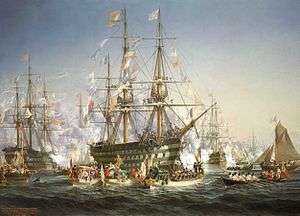
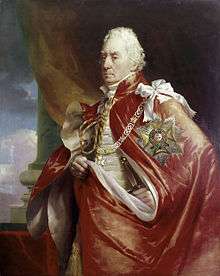
An active loans programme ensures that items from the collection are seen in the UK and abroad. Through its displays, exhibitions and outreach programmes the Museum also explores our current relationship with the sea and the future of the sea as an environmental force and resource.
By virtue of its pairing with the Royal Observatory, the Museum enjoys a unique conjunction of subjects (history, science and the arts), enabling it to trace the movement and accomplishments of people and the origins and consequences of empire. The outcome of the Museum's work is to achieve, for all its users at home and overseas, a greater understanding of British economic, cultural, social, political and maritime history and its consequences in the world today.
The collection of the National Maritime Museum also includes items taken from the German Naval Academy Mürwik after World War II, including several ship models, paintings and flags. The museum has been criticized for possessing what has been described as "Looted art".[4][5] The Museum regards these cultural objects as "war trophies", removed under the provisions of the Potsdam Conference.
The Museum awards the Caird Medal annually in honour of its major donor, Sir James Caird.
The Caird Library
The Museum has the world's largest maritime historical reference library, including over 100,000 books, 20,000 pamphlets, 20,000 bound periodicals including 200 current titles and 8000 rare books dating from 1474 to 1850. The Caird Library is a comprehensive specialist reference library and a rich research resource for all. The reading room is open Monday to Friday, 10.00–16.45, and 10.00–13.00 and 14.00–16.45 on Saturday.
The Archive and Library holds a fantastic range of resources for finding out more about maritime history. Material includes manuscripts, books, charts and maps dating back to the 15th century and comprising the most extensive maritime archive in the world. The collection can be used to research maritime history and exploration, the history of the Merchant Navy and the Royal Navy and much more, including astronomy and timekeeping. Many of the resources they hold are useful for family historians, including large collections of Master’s Certificates dating back to 1845 and Merchant Navy Crew Lists back to the 1860s.
For news and interesting items from the collection, see Caird Library blog To request items to view in the Library, please register at Aeon (the library's ordering system). Search Archive catalogue and Library catalogue.
The Library has produced a range of research guides to help people carry out their own research on a wide range of topics. The guides provide information about the Museum's collections and other sources for research into maritime history. Find out more about the research guides at Research Guides.
The site

The museum was officially established in 1934 within the 200 acres (0.81 km2) of Greenwich Royal Park in the buildings formerly occupied by the Royal Hospital School, before it moved to Holbrook in Suffolk. These buildings had previously been occupied by the Royal Naval Asylum before it was incorporated into the Greenwich Royal Hospital School. It includes the Queen's House (part of the historic park-and-palace landscape of "Maritime Greenwich", which was inscribed as a UNESCO World Heritage Site in 1997) and the Royal Observatory, Greenwich, which was an active scientific institution until the 1950s, when it was removed to Herstmonceux Castle and became known as the Royal Greenwich Observatory.
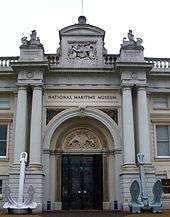
The gardens immediately to the north of the museum were reinstated in the late 1870s following construction of the cut-and-cover tunnel between Greenwich and Maze Hill stations. The tunnel comprised part of the final section of the London and Greenwich Railway and opened in 1878.
Flamsteed House (1675–76), the original part of the Royal Observatory, was designed by Sir Christopher Wren and Robert Hooke and was the first purpose-built scientific institution in Britain.
In 1953, the Old Royal Observatory became part of the Museum. Flamsteed House, was first opened for visitors by Queen Elizabeth II in 1960.
The 17th-century Queen’s House, an early classical building designed by Inigo Jones, is the keystone of the historic "park and palace" landscape of maritime Greenwich.
All the Museum buildings have been subsequently upgraded. A full redevelopment of the main galleries, centring on what is now the Neptune Court, and funded by the Heritage Lottery Fund, was completed in 1999.
The Queen's House was refurbished in 2001 to become the heart of displays of art from the Museum's collection.
In May 2007 a major capital project, "Time and Space", opened up the entire Royal Observatory site for the benefit of visitors. The £16 million transformation features three new modern astronomy galleries, four new time galleries, facilities for collections conservation and research, a learning centre and the 120-seat Peter Harrison Planetarium (named after the major donor, Peter Harrison) designed to introduce the world beyond the night sky.
In 2008, the museum announced that Israeli shipping magnate Sammy Ofer, had donated £20m for a new gallery.
Directors of the National Maritime Museum
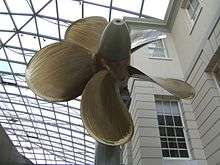
- 1937 to 1946 – Geoffrey Callender
- 1947 to 1966 – Frank George Griffith Carr[6]
- 1967 to 1983 – Basil Jack Greenhill
- 1983 to 1986 – Neil Cossons
- 1986 to 2000 – Richard Louis Ormond CBE (born 1939)[7]
- 2000 to 2007 – Rear Admiral Roy Clare (born 1950) [8]
- 2007 to present – Dr Kevin Fewster[9]
Caird Medal
The Caird Medal was instituted in 1984 to mark the fiftieth anniversary of the National Maritime Museum Act of 1934 that established the museum. The medal is awarded annually to "an individual who, in the opinion of the Trustees of the National Maritime Museum, has done conspicuously important work in the field of the Museum's interests and is of a nature which involves communicating with the public." The medal is named for Sir James Caird (1864–1954), the principal donor at the founding of the National Maritime Museum.
The award of the medal is associated with the Caird Lecture, a public lecture presented by the recipient, which is usually published after the lecture.
The Caird Medalists
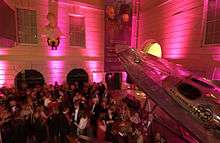
- 1984 Eric McKee
- 1985 Michael S. Robinson[10]
- 1987 Jules van Beylen
- 1989 C. R. Boxer
- 1990 Helen Wallis
- 1991 John F. Coates and John Sinclair Morrison
- 1992 Richard Ollard[11]
- 1993 Gerard L. E. Turner
- 1994 Glyndwr Williams
- 1995 Margaret Rule
- 1996 John de Courcy Ireland
- 1997 Felipe Fernández-Armesto
- 1998 Elly Dekker
- 1999 Elisabeth Mann-Borgese[12]
- 2000 John Hattendorf[13]
- 2002 Robert Ballard
- 2004 Sir David Attenborough[14]
- 2005 Paul Kennedy[15]
- 2006 David Armitage[16]
- 2007 Martin Rees, Baron Rees of Ludlow
- 2010 Willem F. J. Mörzer Bruyns
- 2011 Daniel A. Baugh
- 2014 R.J.B. Knight[17]
Other British maritime museums
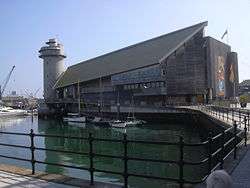
The National Maritime Museum Cornwall is a fully independent museum, a development of the original FIMI (Falmouth International Maritime Initiative) partnership created in 1992 and the result of collaboration between the National Maritime Museum, Greenwich and the former Cornwall Maritime Museum in Falmouth.
Transport connections
| Service | Station/stop | Lines/routes served | Distance from National Maritime Museum |
|---|---|---|---|
| London Buses | National Maritime Museum | 129, 177, 180, 188, 286, 386 | |
| Docklands Light Railway | Cutty Sark | 0.2-mile (320 m) walk[18] | |
| National Rail |
Greenwich | Southeastern | 0.5-mile (800 m) walk[19] |
| Maze Hill | 0.4-mile (640 m) walk[20] | ||
| London River Services | Greenwich Pier | Commuter Service Westminster to Greenwich Express Service | 0.2-mile (320 m) walk[21] |
See also
- Greenwich Visitor Centre
- List of London museums
- National Maritime Museums (list of similarly named museums)
- National Waterways Museum—the UK's national museum of inland waterway transport
- Nederlands Scheepvaart Museum (Netherlands Maritime Museum)
- National Historic Fleet
- Britain and the Sea
References
- ↑ "Visits made in 2009 to visitor attractions in membership with ALVA". Association of Leading Visitor Attractions. Retrieved 21 May 2010.
- ↑ National Maritime Museum, Governing Acts of Parliament.
- ↑ ODNB article by Michael Lewis, ‘Callender, Sir Geoffrey Arthur Romaine (1875–1946)’, rev. H. C. G. Matthew, Oxford Dictionary of National Biography, Oxford University Press, 2004 accessed 23 September 2007.
- ↑ Martin Bailey three articles: (1) "Revealed: Nazi painting in London’s Maritime Museum looted by British." The Art Newspaper. 3 January 2007, (2) http://www.theartnewspaper.com/article01.asp?id=562 How the London Maritime Museum rebuffed a German claim in 1965.] The Art Newspaper. 1 February 2007, (3) http://www.theartnewspaper.com/article01.asp?id=563 "Revealed: six paintings in Maritime Museum were seized by British troops from Nazi Germany."] The Art Newspaper. 1 February 2007
- ↑ Schleswig-Holsteinischer Zeitungsverlag: Gezeiten. Die letzten Tage der Dönitz-Regierung in Mürwik. 21. Dezember 2009; access: 27. August 2016
- ↑ Biography Frank Carr: Ship saver by Peter Elphick, states "Meanwhile, in 1966, the Trustees of the National Maritime Museum dismissed Frank Carr from his post as Director, two years before he was due to retire. No one seems to know the full circumstances behind this highly controversial decision, but it seems that the Trustees wanted a change of course."
- ↑ Who's who entry for Richard Ormond
- ↑ Who's who entry for Roy Clare
- ↑ Biography of Director Kevin Fewster on NMM Website.
- ↑ van der Merwe, Pieter (15 January 2000), "Obituary – Michael Robinson 1910 – 1999", The Independent.
- ↑ Penguin Books author biography: Richard Ollard, accessed 20 October 2007.
- ↑ The Caird Lecture, 1999, by Elisabeth Mann-Borgese: "The economics and governance of the oceans" in Journal for Maritime Research, January 2000. accessed 20 October 2007.
- ↑ The Caird Lecture, 2000, by John Hattendorf: "The Anglo-French Naval Wars (1689–1815) in twentieth-century naval thought"
- ↑ Reference to David Attenborough's Caird Medal Address in Cook's Log: the quarterly newsletter of the Captain Cook Society,Volume 27 No.4 (Oct–Dec 2004) accessed 20 October 2007.
- ↑ Institute of Historical Research Newsletter 2005: Peter Kennedy's Caird Medal Address noted accessed 20 October 2007.
- ↑ Caird Lecture, 2006, by David Armitage: "The Elephant and the Whale: Empires of Land and Sea"
- ↑ Announcement and text of Caird Lecture
- ↑ Google. "Walking directions to the National Maritime Museum from Cutty Sark DLR station" (Map). Google Maps. Google.
- ↑ Google. "Walking directions to the National Maritime Museum from Greenwich station" (Map). Google Maps. Google.
- ↑ Google. "Walking directions to the National Maritime Museum from Maze Hill railway station" (Map). Google Maps. Google.
- ↑ Google. "Walking directions to the National Maritime Museum from Greenwich Pier" (Map). Google Maps. Google.
External links
| Wikimedia Commons has media related to National Maritime Museum, London. |
- Official website of the National Maritime Museum
- The official prints website of the National Maritime Museum containing a selection of the museum's finest images
- National Maritime Museum Photostream (many photos labeled: "no known copyright restriction") at Flickr.com